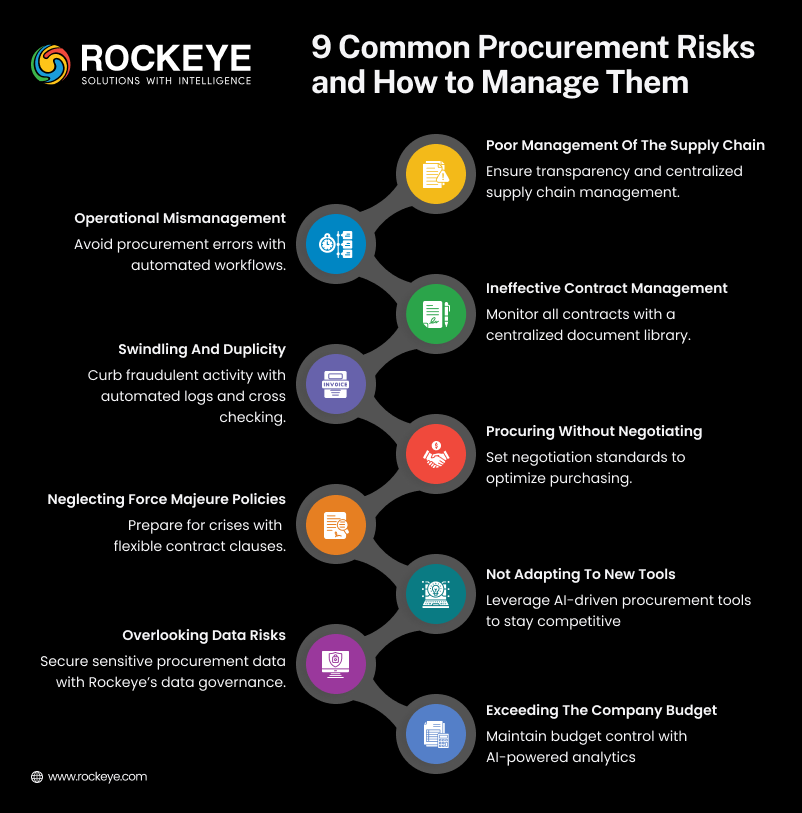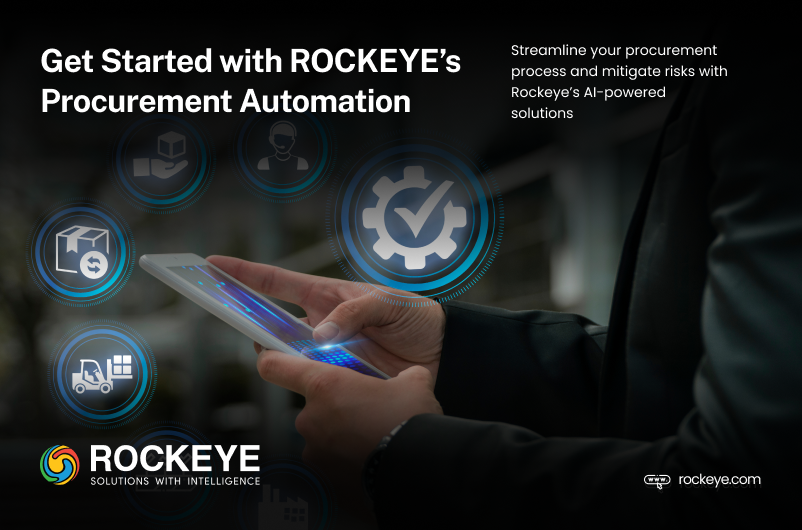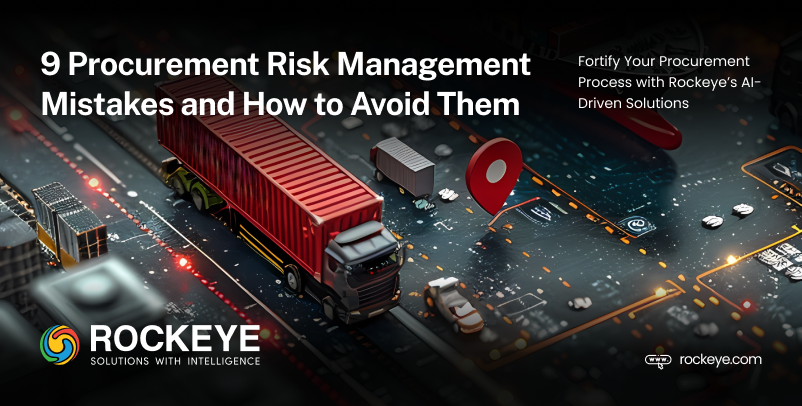Procurement Risk Management: How to Mitigate Common Risks
As a general rule, businesses thrive when all their procurement needs are being met. Organizations should be able to receive their goods and services through cost-effective means and in a reliable and secure manner for the procurement process to be deemed acceptable.
However, several factors might impede procurement. Businesses, therefore, need to have a process in place to manage and mitigate these risks, ensuring smooth operations. Moreover, numerous mistakes tend to occur during the procurement of goods and services.
In this blog, we will outline the most common procurement risks and how to manage them.
Common Procurement Risks

Risk #1 : Poor Management of the Supply Chain
If the supplier relationship management is not sorted and you haven’t taken the necessary steps to ensure a fully transparent, centralized supply chain management system, you might just run the risk of rogue spending. Moreover, if your business doesn’t have an accessible way to deal with requests, purchase , approvals, and payments, you also run the risk of bogus invoices and untrustworthy vendors.
Remedy : By investing in AI technology and cloud-based services such as ROCKEYE’s procurement software, businesses could establish a vendor portal that allows the platform to automate the management and evaluation of vendors. Such software could ensure that rogue spending is curbed by assigning roles for purchasing approvals, requests, and so on.
Risk #2 : Operational Mismanagement
As with any business, there are plenty of times when an organization mismanages aspects of procurement, such as not knowing what goods and/or services the company would need, when it would need them, or whether arrangements have been made for timely delivery. There is also the concern of whether you’ve procured it for the best price possible. As a result, the company might end up procuring either too many goods, too few, purchasing the wrong set of goods, or buying them at less than optimal prices without negotiating for a discount and so forth.
Remedy : A powerful procurement software would provide all the essential tools needed to address such challenges, as big data and information technology have greatly contributed to improving the supply chain management process.
Risk #3 : Ineffective Contract Management
Since a contract more or less decides the relationship between a procurement officer and a vendor, businesses must ensure that every precaution is taken to monitor them. A number of organizations have reported how the lack of monitoring has led to many procurement risks.
Remedy : Businesses could establish a centralized document library where all terms are automatically linked to approved vendors only. All transactional data would then be transformed into reports for finance, marketing, and negotiations handled by upper management.
Also Read: Purchase Order vs Invoice: Key Differences and Why They Matter
Risk #4 : Swindling and Duplicity
Granted that most risks are a result of mismanagement and inefficiency, but there are some that are a consequence of malice with intent. Embezzlement, invoice fraud, and theft through falsifying records all fall under this category.
Remedy : Automated procurement tools, catalogs limited to authorized and preferred vendors, and comprehensive transactional information logs with document cross-checking functionality all help businesses mitigate procurement risks effectively.
Risk #5 : Procuring Without Negotiating
Although it is understood that businesses want to create a lasting, trusting relationship with their vendors, being accepting of whatever price vendors quote for goods and services isn’t going to make your company flourish. What is more important is that as a company, you set the right standards for quality goods and services that will be supplied to you. This is not to say that you resort to unprofessional, outright bargaining means as well.
Remedy : Ensure that you take into account additional procurement charges such as shipping, packing, and so on. You can also utilize tools like ROCKEYE, which offers a comparison channel to evaluate various vendor propositions, helping you make informed and budget-friendly decisions without compromising on quality.

Risk #6 : Neglecting Force Majeure Policies
As a result of the pandemic and the ensuing lockdown situation, businesses start looking at all the ways through which they can minimize procurement risk. One such step would be to go through the Force Majeure clauses and all its terms. It is because of clauses such as these that businesses are given flexibility when it comes to deferring, terminating, or renegotiating prior commitments with one’s suppliers so as to ease the burden during such uncertain times.
Remedy : Software solutions help businesses navigate these clauses, offering the flexibility required to manage supplier relationships during crises.
Risk #7 : Not Adapting to New Tools
Few businesses are of the opinion that technological innovations don’t bring much to the table when it comes to managing procurement risks as well as supply chain management as a whole. As such, they refuse to make use of advanced procurement tools that could simplify and reduce costs and also take the aid of automation techniques to complete their tasks efficiently.
Remedy : By making use of the right kind of autonomous procurement tools like ROCKEYE, businesses can then focus their efforts on other strategic initiatives. For a comprehensive look at the top procurement solutions that every enterprise will need in 2024, check out this article.
Risk #8 : Overlooking Data Risks
By disregarding data security as well as the data privacy of all parties involved in the supply management chain and the commercial transactions that follow, companies run the risk of a breach in their data.
Remedy : Businesses should adopt robust cybersecurity solutions and invest in automated systems that continuously monitor and assess data security risks. These tools can help detect vulnerabilities, ensuring compliance with data privacy regulations and protecting the sensitive information involved in supply chain management.
Risk #9 : Exceeding the Company Budget
There are many reasons as to why a company would exceed its budget. This would include rogue spending, overspending in order to procure goods and services, and an absence of communication and coordination amongst employees, suppliers, and management.
Remedy : In order to avoid such procurement risks, businesses can invest in artificial-intelligence-backed solutions like ROCKEYE that govern, classify, organize, and analyze the umpteen number of transactions that occur on a daily basis.
About Us:
ROCKEYE is a next-gen cognitive suite for business operations, offering AI insights, cloud efficiency, and a comprehensive range of scalable, flexible, and secure solutions. Covering areas such as finance, HR, procurement, inventory, production, and more, ROCKEYE helps businesses streamline operations and improve productivity with its user-friendly automation tools.


